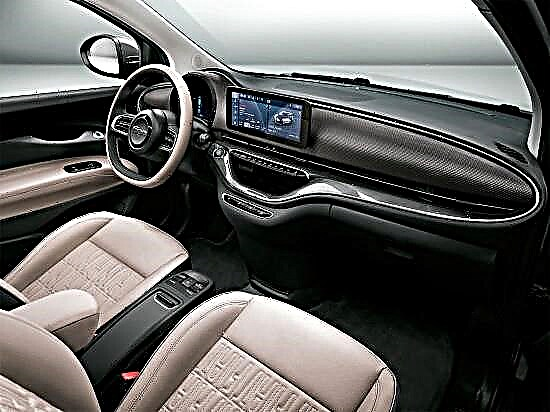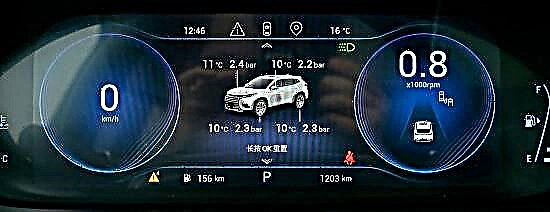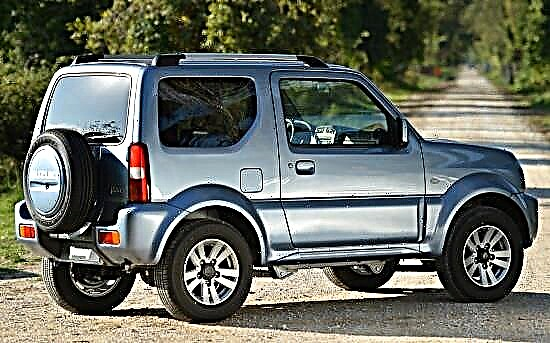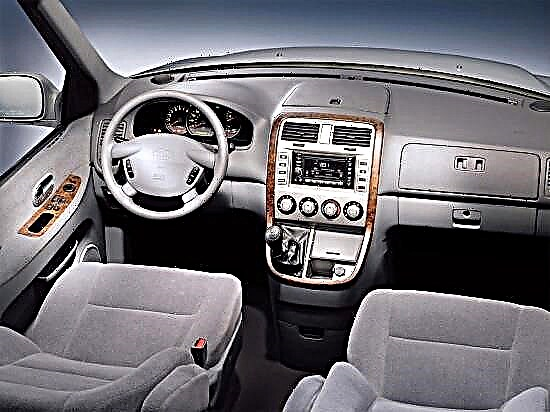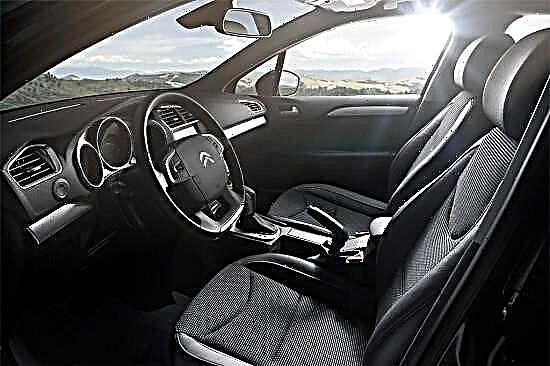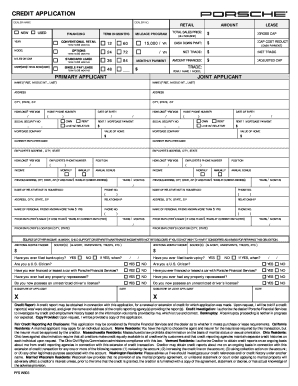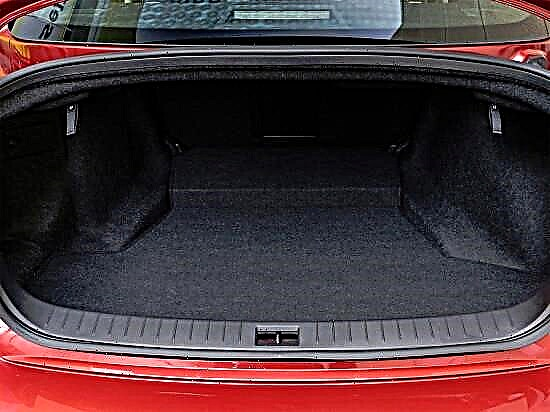In January 2013, Infiniti unveiled a new premium mid-size sedan called the 'Q50' at the Detroit International Auto Show.
The car, in fact, is the next generation of the G-series sedan, which is well known to Russian buyers, and its main competitors are the BMW 3-Series, Audi A4, Lexus IS and Cadillac ATS.

In December 2015, the four-door underwent a technical update that bypassed the design - it was separated by a 3.0-liter V6 engine in two stages of boost, and adaptive steering (DAS) was reconfigured, extolling the natural feedback in it, and the suspension ...
Well, in March 2017, the car underwent a planned restyling, making its debut at the motor show in Geneva - this time the exterior was "refreshed" (due to tweaked bumpers, grille and lights), minor changes were made to the interior and new equipment was installed ( in particular, the ProPilot semi-autonomous driving system).

Sedan Infiniti Q50 has a deliberately aggressive and assertive appearance, which is fully consistent with the latest design trends of the Japanese luxury brand.
The front of the car is crowned with a "family" radiator grille and a piercingly sharp, frowning glance of the head optics (in the basic version it is halogen, and in the more expensive ones it is LED). No less impressive are the muscular relief of the bonnet and the bumper, which accommodates the air intake (covered with an openwork mesh) and compact fog lights, above which the LED daytime running lights are located.
The profile of the Infiniti Q50 immediately catches the eye with its dynamism, which is created by the sloping roof, turning into a beautiful curve, stylish sill rib and large rims (diameters ranging from 17 to 19 inches).
The rear of the premium sedan stands out with its flowing LED lights, a powerful bumper with twin exhaust pipes and a small spoiler that adorns the boot lid.

The Infiniti Q50 sedan looks larger than it actually is, and it’s even hard to imagine that its direct competitors are D-class three-box cars, and not representatives of the business segment. Indeed, in terms of size, the "Japanese" is located right between the named niches: 4790 mm in length, 1820 mm in width and 1445 mm in height. The wheelbase is 2850 mm, and the ground clearance is 130 mm.
The curb weight of the car fluctuates in the range of 1640 ~ 1800 kg (depending on the modification).

The interior space of the Infiniti Q50 fully complies with the canons of the premium segment - correctly calculated ergonomics, well-located controls, high-quality finishing materials and rich equipment.
The dashboard looks beautiful and laconic, it is not overloaded with unnecessary functions and provides all the necessary information for the driver's eyes (it is displayed on the color display between the main instruments).
The three-spoke steering wheel carries a high payload - it houses the buttons for music, cruise control and on-board computer.
The center console looks elegant, modern and expensive, and it is crowned with two color displays at once. The upper display with a diagonal of 8 inches is slightly recessed in the dashboard, does not indulge in high resolution and is responsible for displaying the navigation picture from all-round cameras. The lower 7-inch screen is endowed with clear graphics and a beautiful interface and displays the data of the multimedia system. It is worth noting that the buttons for controlling the "music" and the air conditioner are placed in separate blocks - convenient and logical!

The front seats of the Infiniti Q50 are designed in collaboration with NASA, they are endowed with good lateral support and a lot of electrical adjustments. They have one drawback - ventilation is not even offered as an option.
Seemingly flat, the back sofa has soft padding and a comfortable layout, but the central tunnel clearly indicates that the third one will be superfluous here. But two people will sit down with a high level of comfort (there is enough space in all directions), and from the elements of convenience - ventilation deflectors and an armrest in the center with a pair of cup holders.
The premium sedan has a 500-liter luggage compartment in its arsenal. However, the dimensions of the transported cargo are limited by the wheel arches, which protrude strongly inward, and a rather narrow opening into the cabin with the backs folded down (in a ratio of 60:40). In the underground - only a tool, there is no spare wheel, since the Infiniti Q50 is equipped with run-flat tires.

In the Russian market for the Infiniti Q50, two gasoline engines are offered, which are combined exclusively with a 7-band "automatic" with a manual transmission mode. But if the "junior" version fits exclusively with the rear-wheel drive transmission, then the "senior" relies on an all-wheel drive system with a multi-plate clutch, which, if necessary, supplies traction to the wheels of the front axle.
- Under the hood of the base sedan is a "four" with in-line cylinders, direct injection and turbocharging. The engine displacement is 2.0 liters (to be more precise, 1991 cubic centimeters). It generates a maximum of 211 horsepower at 5500 rpm and 320 Nm of torque at 1250-3500 rpm.
It takes 7.3 seconds for such a three-volume vehicle to accelerate to the first "hundred", and only when it reaches 245 km / h the speed gains stop. Its fuel efficiency indicators are at a high level: in the combined cycle, every 100 km of the track, the tank (74-liter in total) is emptied by 7 liters (9.3 liters are enough in the city, 5.7 liters on the highway). - The "top" car is equipped with a 3.0-liter (2997 cubic centimeters) V6 engine of the VR series with two turbochargers, direct fuel injection, an exhaust manifold built into the head of the unit and phase shifters with high-speed electric motors generating 405 hp. at 6400 rpm and 475 Nm peak potential at 1600-5200 rpm.
In this version, the four-door takes off from standstill to 100 km / h after 5.4 seconds, accelerates to 250 km / h, and "drinks" 9.3 liters of gasoline in combined conditions (in the city - 13.3 liters, on the highway - 7 liters).
At the heart of the Infiniti Q50 is the rear-wheel drive "trolley" Nissan FM (Front Midship), on which the G-series model was also built (although it was modernized on the new sedan). The suspension scheme is as follows - double wishbone on the front axle and multi-link on the rear (versions with a V-shaped "six" can boast an adaptive chassis with electronically controlled shock absorbers). Aluminum alloys and high-strength grades of steel are widely used in the body structure, due to which the curb weight of the basic three-volume box does not exceed 1640 kg.
The Infiniti Q50 is equipped with an electromechanical power steering, but this is on the base cars. The top-end sedan is equipped with Direct Adaptive Steering. Its essence lies in the fact that the steering wheel and front wheels are not mechanically interconnected, but are responsible for all the electronics: three electronic control units analyze information from a variety of sensors, and then send the necessary commands to a pair of electric motors. It is worth noting that if the electronics fail, then there is a mechanical connection between the steering wheel and the wheels by means of an electromagnetic clutch. And the effective braking system with ventilated discs, 4-channel ABS, electronic brake force technology (EBD) and emergency braking assistance (BA) is responsible for the car deceleration.
The restyled Infiniti Q50 is delivered to the Russian market in four versions - “Pure”, “Luxe”, “Sport” and “Red Sport” (the first three are offered for cars with a 2.0-liter engine, and the last one - with a 3.0-liter one).
- For the basic configuration, they ask for a minimum of 1,999,000 rubles, for which it is equipped with: six airbags, a two-zone "climate", halogen headlights, a fabric interior, starting the engine from a button, heated front seats, a "cruise" with a speed limiter, a media center with two displays , an audio system with six speakers, ABS, ESP, 17-inch alloy wheels, hill start assistant and other modern equipment.
…
- The "top" version costs from 2,999,000 rubles, and its features are: adaptive suspension, sports brakes, electric sunroof, 19-inch "rollers", leather interior trim, full LED optics, semi-autonomous ProPilot package, automatic parking system, adaptive DAS steering, memory and power adjustment of the front seats and the "darkness" of other "goodies".


